How it works
DE-OIL-IT breaks down the oils and lipids into millions of molecular/nano-sized particles and will not allow them to quickly regenerate like other detergent-type cleaners, making cleanup easier and more efficient. A surface cleaned with DE-OIL-IT will feel clean to the touch.
The key to DE-OIL-IT is the technology used to develop a “colloidal micelle.”
Since DE-OIL-IT is a non-toxic blend of chemicals that work by colloidal formation to remove oil, grease, and grime safely, easily, and efficiently, it works differently from solvents or caustic-based cleaners.
Colloidal micelle breaks down long chain hydrocarbon bonds in oils, fats, grease, fuels, etc., and holds them in suspension at a nanoscale. Individual micelle repels each other causing no greasy residue left after cleaning. This suspension acts as an emulsified layer on top of water and in soil, the surfactant properties of De-Oil-It drive the micelle down to layers in the soil where bacteria can complete the biodegrading process.
When a micelle contained in the DE-OIL-IT product comes in contact with a hydrocarbon molecule, the center of the micelle bonds to a similar hydrophobic hydrocarbon. It disrupts the attraction to other hydrocarbon molecules and/or to the surface.
The action of a single micelle is multiplied by billions of other micelles. The molecular level emulsification process penetrates highly viscous and sticky materials namely hydrocarbon-based, lifting them from the surface to which they adhere.
When many micelles are in close vicinity to others a “colloidal micelle” is formed and this results in an emulsified layer on top of the water. On land/soil, the surfactant properties of De-Oil-It drive the micelle into the soil to then be accessible to indigenous bacteria that will complete decomposition via a biodegrading process.
Considering the damage inflicted on life and the planet by harsh cleaners and solvents, colloidal chemistry represents an exceptional advance toward environmental preservation and restoration.
Note: “detoxified” claim based on hydrocarbon measuring equipment producing Parts per Million, PPM, to quantify contamination levels. The Industrial Strength Concentrate (ISC) formula properly diluted has been used to reduce hydrocarbon contamination (“pollution”) to below the regulated levels to nearly negligent levels. Detoxification (“reducing hydrocarbon PPM levels”) is based on data from 350+ remediation projects, many supervised by the EPA, and averaged 4-6 weeks versus conventional remediation timelines of 3-4 months. “No longer a threat” is based on lab readings of soil samples showing typically no detection of hydrocarbons. The concentrated formula is highly alkaline but when diluted with water and applied to a hydrocarbon pH ranges 7.2 to 8.2 which is an optimal range for indigenous bacteria to complete the breakdown of complex hydrocarbon chemical structures via biodegrading meaning the bacteria eat, consume degraded hydrocarbons and their digestive system releases smaller simpler chemical structures, completing a transformation into elementary non-contamination.
